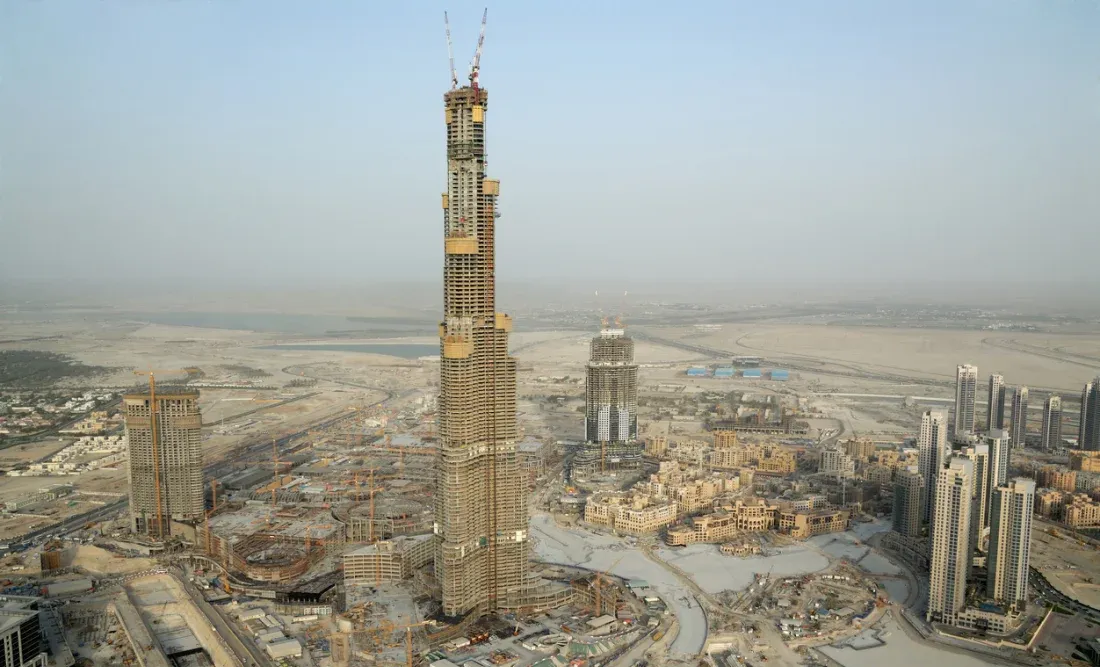
The Burj Khalifa was conceived in the early 2000s as part of Dubai’s plan to become a global city. The government of Dubai, led by Sheikh Mohammed bin Rashid Al Maktoum, aimed to create a structure that would symbolize the city’s growth and aspirations. Construction began in 2004, and the building was completed in 2010. Initially named “Burj Dubai,” it was renamed Burj Khalifa in honor of the UAE’s President, Sheikh Khalifa bin Zayed Al Nahyan, who supported the project financially during the 2008 financial crisis.
The Burj Khalifa officially opened on January 4, 2010, in a grand ceremony. Since then, it has become a symbol of Dubai’s economic success and a major tourist attraction, offering breathtaking views from its observation decks and drawing millions of visitors.
The architecture of the Burj Khalifa is a blend of cultural influences and cutting-edge technology. The design was inspired by the Hymenocallis, a regional desert flower, whose harmonious structure provided the basis for the building’s footprint. The Burj Khalifa’s shape is characterized by a triple-lobed footprint, an abstract representation of the flower’s form, with three sections arranged around a central core. This design not only adds to the building’s aesthetic appeal but also provides structural stability, allowing it to withstand the high winds that can occur at such great heights.
The exterior of the Burj Khalifa is clad in glass, aluminum, and stainless steel, giving it a sleek, modern appearance. The reflective glass is designed to withstand the extreme temperatures of the desert, helping to reduce heat absorption and enhance the building’s energy efficiency. The tapering shape of the tower, which becomes narrower as it rises, also contributes to its stability, reducing wind load and making the structure more aerodynamic.
The Burj Khalifa’s design incorporates several innovative features, such as its Y-shaped floor plan, which maximizes natural light and offers stunning views of the surrounding cityscape. The building also has one of the world’s largest fountains, the Dubai Fountain, located at its base, which adds to the overall grandeur of the structure.
Inside, the Burj Khalifa is equally impressive. The interiors are luxurious, featuring a mix of glass, polished dark stones, stainless steel, and fine leather. The design of the interiors was overseen by Giorgio Armani, who also designed the Armani Hotel, located on the lower floors of the building. The building is equipped with state-of-the-art amenities, including swimming pools, a fitness center, and residential and commercial spaces.
The Burj Khalifa was designed by Skidmore, Owings & Merrill (SOM), a Chicago-based architectural firm, with Adrian Smith as the chief architect. Smith, renowned for his work on supertall skyscrapers, aimed to create a structure that was both functional and aesthetically pleasing. His design for the Burj Khalifa reflects a desire to symbolize Dubai’s growth while ensuring the building could withstand the unique challenges posed by its height and location.
One of the key engineering challenges was developing a structural system that could support the building’s unprecedented height. SOM’s structural engineering team, led by William F. Baker, developed the “buttressed core” system. This innovative design uses a central hexagonal core reinforced by three buttresses, providing exceptional stability and allowing the building to reach its towering height.
Adrian Smith’s work on the Burj Khalifa has been widely recognized, and the building has received numerous awards for its design and engineering. The Burj Khalifa has also influenced the design of other supertall skyscrapers worldwide, solidifying Smith’s reputation as a leading architect in the field.
BURJ KHALIFA TICKETS
Visiting the Burj Khalifa, the world’s tallest building, is a must-do experience when in Dubai. However, to fully enjoy the visit, understanding… see more
TRAVELER INFORMATION
Getting to the Burj Khalifa is straightforward, with multiple transport options available. Visitors can choose between arriving by car… see more
BURJ KHALIFA INFORMATION
The Burj Khalifa, standing at 828 meters, is a symbol of Dubai’s ambition and innovation. As the tallest building in the world, it offers a vari… see more
